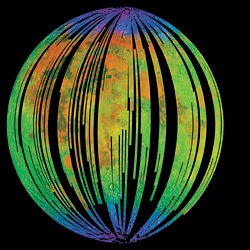Back to the Moon
In a rare one-two blow to the long-held idea that the moon is a desert, two geology professors separately confirmed the presence of water on the moon this fall.
First, Professor of Geological Sciences Carle Pieters was the lead author of a September Science paper reporting that instruments aboard an unmanned Indian spacecraft had found that the moon's soil could contain up to 1,000 parts per million of water molecules. Then, in November, Professor of Geological Sciences Peter Schultz, co-investigator of a NASA satellite that was sent crashing into a frigid, dark crater near the moon's south pole, reported that the impact definitively revealed the presence of lunar ice. "We got more than just a whiff," Schultz told the New York Times. "We practically tasted it with the impact."
Pieters, who conceived and designed the Moon Mineralogy Mapper that the Indian Space Research Organization's Chandrayaan-1 spacecraft ferried to the moon this fall, at first couldn't believe what the instrument was telling her. "We kept getting this [data], and we thought, 'Well, there's probably something wrong with our calibration. We'll have to fix that,'" Pieters says.
It wasn't until two other instruments had verified her team's findings that Pieters finally accepted them: "To have three instruments independently see the same thing in the same manner, there's no question. It's real."
Schultz's team sent NASA's Lunar Crater Observation and Sensing Satellite (LCROSS) crashing at 5,600 miles an hour into a permanently shadowed lunar crater on October 9. Because such craters and the lunar poles are among the coldest places on the moon, scientists have long thought that these would be good places to look for water ice.
Crashing a satellite into one such crater, they hoped, would send up a great plume of debris that could reveal the makup of the surface. Although observers were initially disappointed that even high-powered telescopes were unable to view the plume, further analysis revealed color shifts after the impact that showed unmistakable signatures of various molecules, including those of water. Commenting about the presence of moon water after the Chandrayaan-1 results were published, NASA scientist Jack Burns said, "I rank this as a game changer for lunar science. In my mind this is possibly the most significant discovery about the moon since the Apollo era."
This discovery of water is important for two reasons. The first is that it changes the way scientists understand the processes that shaped the moon—and, by extension, its nearest neighbor, the earth—throughout its 3.5 billion-year history, and that continue to shape it today. The second, says Pieters, is that "for human exploration, water is gold." Transporting water from earth is prohibitively expensive—some put the cost as high as $100,000 per gallon—and any extended stays on the moon or in space in the future would require additional sources of water.





